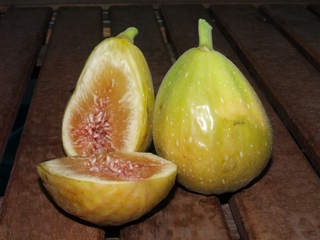Autofertile (parthénocarpique)
Bifère (Figues- fleurs début juillet, figues d’été début août)
Cette variété a été décrite la première fois en 1667 par Merlet.
Les informations recueillies par Ira Condit Hilgardia montrent les contradictions dans l'identification d'une variété quand il n'a que les caractéristiques morphologiques Arbre de croissance lente et de développement modeste.
Début juillet, il donne une petite production de figues-fleurs de bonne taille et de qualité acceptable.
Les figues d’été, plus abondantes, sont assez douces avec une tendance à se fissurer.
Peau très fine et délicate. Son nom, comme pour beaucoup d’autres figues, fait référence à la goutte épaisse et sucrée qui s’écoule de son ostiole.
Page traduite avec la collaboration de Nadia Habib.
Publié à Hilgardia per Ira Condit.
Dorée (syns. Figue d’Or, Goutte d’Or). Described by Merlet (1667), Ballon (1692), Liger (1702), Langley (1728), Société Pomologique de France (1887, 1947), Eisen (1888, 1901), Starnes and Monroe (1907), Juignet (1909), Simonet et al. (1945), and Delbard (1947).
Illustrated in black and white by Starnes and Monroe and by Simonet. Illustrated in color by Delbard. Dorée is a French fig, reported by Merlet and other early writers to be subject to splitting or cracking of the skin, and therefore good only for hog feed; the checked skin also suggested to them the torn robe of a beggar; in general, however, it is described as a handsome fig of excellent quality. Starnes found in Georgia that Dorée appeared to be the same as Magnolia (Brunswick), a report which casts doubt on the identity of the specimens grown.
It is doubtful, moreover, whether the true Dorée has ever fruited in California, although P.I. No. 18,897 of the Chiswick collection was labeled as that variety; no trees are now known to occur in collections of varieties. P.I. No. 102,013, introduced from Morocco in 1933 as Goutte d’Or, was found to be the same as Dottato at Riverside.
Tree of Dorée produces two crops. Leaves medium to small, 3- to 5-lobed. Description is after Simonet, from fruit grown at Bagnols-sur-Ceze. Brebas large, elongated-pyriform, somewhat oblique; length 3-1/4 inches, diameter 2-1/4 inches; average weight 85 grams; neck not distinct, merging gradually with the body; stalk conical, swollen toward the junction with the fruit, about 1/2 inch long; ribs not very well marked; eye in a slight depression, large, half open; scales erect, yellow to rose-colored; skin delicate, yellowish green, becoming golden yellow slightly tinged with rose on the exposed side; pulp salmon; texture fine; seeds few; quality fair.
Second-crop figs smaller, globular, or short-pyriform; stalk swollen; ribs none; color same as brebas; pulp light rose. Quality good; excellent for drying. Douqueira Blanca. Described by Sauvaigo (1889) and Eisen


